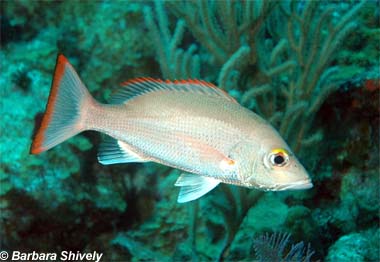
Lutjanus mahogoni
This colorful reef fish grows to an average 15 inches long but has been caught larger. It is a dark gray to olive on top, with silvery sides and a distinct black spot on its upper back. There is a reddish tint to much of its body, and its fins have rusty red highlights. Although it is a popular food fish, it has been linked to ciguatera poisoning because it is higher on the reef food chain.
Order: Perciformes
Family: Lutjanidae
Genus: Lutjanus
Species: mahogoni
Common Names
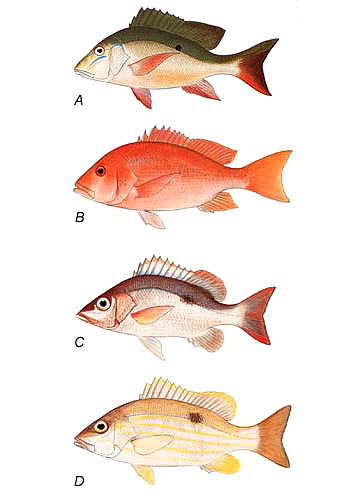
English language common names include mahogany snapper, mahogony snapper, lantern jaw, and spot snapper. Other common names include colulie and kalala (Papiamento); lucjan kaszmirski (Polish), ojanco, pargo, pargo ojon, rayado de yerba, and sama ojua (Spanish); sarde and vivaneau (French); schnapper (German).
Importance to Humans
The mahogany snapper is utilized as a food fish and as a game fish. It is primarily caught with traps, spears, gill nets and hook and line gear. The flesh is usually marketed fresh.
There have been reports of ciguatera poisoning from specimens of this snapper. Ciguatera poisoning is caused by free swimming dinoflagellates or other algae on dead corals. Certain fishes eat these dinoflagellates and algae, and the snapper then feeds upon those fishes. The dinoflagellates and algae have toxins that build up in the predatory fish’s liver and flesh, and if it reaches a certain level, it can cause poisoning to humans who eat the snapper. Poisoned people report having gastrointestinal problems for up to years, and a general weakness in their arms and legs. It is very rare to be afflicted with ciguatera poisoning, but caution should be exercised when consuming large predatory fishes such as snappers, barracudas, and jacks in the tropics.
Conservation Status
The mahogany snapper is not listed as endangered or vulnerable by the World Conservation Union (IUCN). The IUCN is a global union of states, governmental agencies, and non-governmental organizations in a partnership that assesses the conservation status of species.
> Check the status of the mahogany snapper at the IUCN website.
Geographical Distribution
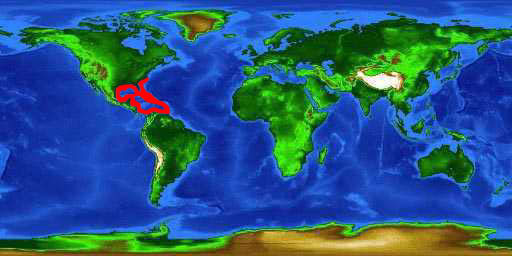
The mahogany snapper is found in the western Atlantic Ocean, from the Carolinas to Venezuela, including the Gulf of Mexico. It is very common in the Caribbean and around Bermuda.
Habitat
This snapper lives near shore or offshore in clear, shallow warm water over rocky bottoms and coral reefs and less commonly over sandy areas and seagrass beds. Their depth ranges to depths of 325 feet (100 meters). As a warm water species, it is found in temperate waters only during the heat of the summer. Mahogany snappers drift alone or in small groups over coral reefs, often among gorgonians and hard corals, or in crevices and caves.
Biology
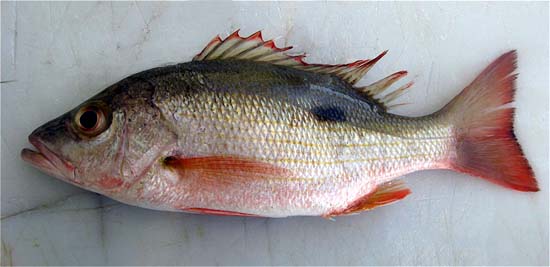
Distinctive Features
This snapper has a relatively deep body. The belly runs straight from the mouth to the anal fin. It has a pointed snout and large eyes. The lower jaw projects beyond upper jaw. The anal fin is rounded, more than usual in snappers. It has a bi-lobed dorsal fin and long pectoral fin, as found in other many lutjanid fish. The anal fin is rounded. The caudal fin is moderately forked.
Coloration
Mahogany snappers are very colorful fish. Their back and upper sides are gray to dark olive, becoming silvery on the lower sides and belly. There may be a red tinge throughout the entire body. There is a conspicuous black spot on the upper back, below the anterior soft dorsal fin rays. The fins are red to yellow and the caudal fin has a dusky margin.
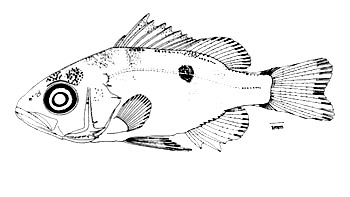
Dentition
The canine teeth in both jaws are approximately equal in size. The vomerine tooth patch is either v-shaped or crescent-shaped with an elongated extension.
Size, Age, and Growth
The mahogany snapper has an average length of 15 inches (38 cm), with a maximum length of 19 inches (48 cm).
Food Habits
The mahogany snapper feeds nocturnally on small bottom fishes such as grunts. It also feeds on marine invertebrates including shrimp, cephalopods, and crabs.
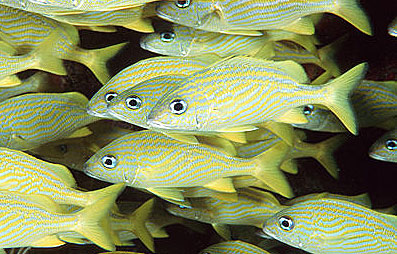
Reproduction
Spawning occurs during the months of May, June, and July throughout the mahogany snapper’s range. They most commonly spawn in the northeastern Caribbean Sea. Pelagic eggs are released and are dispersed by the ocean currents. After fertilization occurs, the eggs hatch within a day. Although little is known about the larvae, they are planktonic at lengths less than 10 mm. They eventually settle out of the plankton, onto suitable habitat that offers some protection from predators. Juveniles have been described as pale with pink to red pigmentation on the distal portions of the median fins, and a prominent spot on the upper back.
Predators
Predators of the mahogany snapper include sharks and other large predatory fishes, including other species of snappers.
Taxonomy
Lutjanus mahogoni was first described by Georges Cuvier in 1828 based on a specimen from Martinique. Synonyms in past scientific literature that also refer to this species include Mesoprion recardi Cuvier, 1828 and Mesoprion ojanco Poey, 1860.
Prepared by: Rebecca Murray and Cathleen Bester